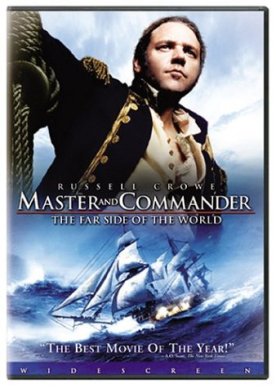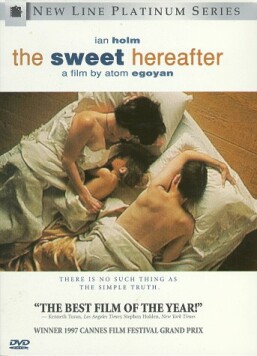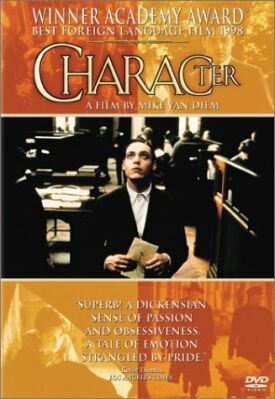Master and Commander: The Far Side of the World
There were some things I didn’t much care for about Master and Commander: The Far Side of the World, Peter Weir’s adaptation of a couple of novels by Patrick O’Brian. I thought Russell Crowe was at times a bit too oafish, in his contemporary Australian way, to be Captain “Lucky” Jack Aubrey, a British naval officer of the Napoleonic era. Not having read the books, I don’t know if Aubrey is supposed to be a bit of an oaf, but if he is I assume he is at least a Britannic and Napoleonic era oaf. He also sometimes says things like this, of a stubborn enemy: “What is it with this man? Did I kill a relative of his in battle perhaps?” Not his fault, of course, but the “What is it with. . .?” formulation is distinctively 1990s, like something out of “Seinfeld.”
Nor did I believe in the decidedly post World War, post-Vietnam variety of insubordination indulged in by Stephen Maturin (Paul Bettany), Aubrey’s great friend and the doctor on his ship, H.M.S. Surprise. And as for Maturin’s suggestion to the captain that he “tip the men’s grog over the side” to increase their health and efficiency, the idea is ludicrous — unless, as seems hardly likely, he was motivated by Wesleyan religious principles. The sub-plot in which Maturin in the Galapagos Isles almost becomes, but does not quite become, Charles Darwin thirty years ahead of time I found too knowing and a distraction from the much more interesting existential adventure of sinking or being sunk.
The romance of “progress” is also suggested in the innovative design of the French ship, Acheron — said to be “Yankee-built” for fear, presumably, of giving the French credit for anything, or anything but cunning — with which the Surprise is engaged in an epic chase in the South Atlantic, around Cape Horn and up the Pacific coast of South America. “What a marvelous world we live in!” says Aubrey after explaining the superiority of his adversary’s design when it is revealed to him in a model — made by one of his men who had been visiting a cousin in Boston as the ship was being built. But the celebration of progress, with its implied congratulation to the old-timers for being more like us than they really were, doesn’t add anything to the heroism of these sailors and is, rather, a melancholy reminder of what was eventually to make it, in the view of many a modern rationalist, hardly heroic at all.
But while the film sticks to what it does best, which is its recreation of the naval warfare of two hundred years past, it is well-worth seeing. Visually it is a real treat, and considerable care has obviously been taken to get the period detail right, with special attention to the rough-and-ready nature of surgery at sea in 1805 and the effects of canister and chain-shot on the delicate tracery of woodwork and sail and rigging that made the gorgeous square-rigged vessels of the period go. In fact, the beauty of the ships serves as a kind of visual analogue for that of the community on behalf of which these men are fighting. “This ship is England,” says Aubrey, and it is perhaps easier to believe that civilization can take precedence over the lives of individual soldiers or sailors, and make it fitting and proper for them to risk them on its behalf, when the embodiment of civilization is a triumph of human artistry and ingenuity such as this.
That must be why the drama of Captain Aubrey’s command is made to center around a series of decisions to sacrifice individuals for the sake of the ship, or of its mission. Aubrey even doubts himself and his Nelsonian delight in battle as he is made to wonder whether or not “chasing this bigger, faster ship with its long guns begins to smack of pride.” Still, he does not turn back from what promises to be another dire encounter. Only when the life of Maturin himself hangs in the balance does Aubrey show his endearingly soft and human side by turning the ship aside from its self-imposed task and putting in to the Galapagos Islands — where unexpectedly he finds after all his best chance to engage with the enemy.
It is at least a nice touch that when Aubrey learns the principle of natural camouflage from Maturin’s exotic beasts — “I had no idea that the study of nature could advance the cause of naval warfare,” he says — he has to be reminded that he is the predator, not the prey. I myself would have liked to have seen a bit more of the Frenchies, whose presence is sufficiently accounted for so far as the men are concerned by the spectre, conjured up for them by Aubrey in a stirring address before the mast, of a guillotine in Piccadilly. That’s ideological warfare for you! But an old-fashioned action movie, which this so nearly resembles, can do without such an old-fashioned tribute to the brotherhood of arms, so long as the arm of its hero-captain is so mighty.
Discover more from James Bowman
Subscribe to get the latest posts to your email.







